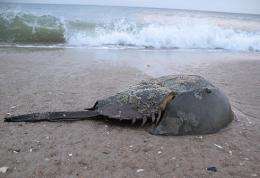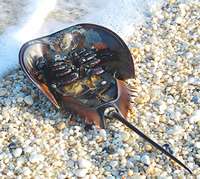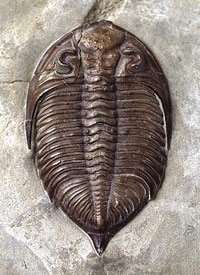Horseshoe crabs are one of nature's great survivors

It may look like something out of a science fiction movie, but the horseshoe crab is definitely real. In fact it is one of nature’s great survivors, lasting through 3 of the Earth’s major extinction events.
These and other indestructible creatures are the topic of a BBC television series starting tomorrow, based on the book Survivors by Natural History Museum fossil expert Richard Fortey.
The horseshoe crab and its relatives have been around for at least 450 million years. The most devastating extinction event that they survived has been called the Great Dying and happened around 250 million years ago.
This period had phases of major environmental change, ending with a catastrophic event, which included some of the greatest volcanic activity the world has seen.
Extinction
The Great Dying wiped out most of the Earth’s species. Some scientists have estimated 96% of marine species, 70% of terrestrial vertebrates and 57% of insect families became extinct. But the strange-looking horseshoe crab, with its armoured shell and long rigid pointed tail, lived on.
What adaptations helped the horseshoe crab?
A horseshoe crab upside down. These animals have survived 3 of Earth's extinctions that wiped out most other species.

So, what is it about horseshoe crabs that enabled them to survive? "Being able to feed on almost any organic matter helped," says Fortey.
"And, they have a special kind of blood, which is blue! It coagulates when it encounters bacteria. They can 'wall up' any wounds they receive."
Another key to their survival seems to be their tolerance of habitats that fluctuate in salinity (levels of salt). When environmental changes happen, they can move to safety.
An ability to live with low levels of oxygen is also important. Fortey adds, ‘The horseshoe crab was able to cope with periods of oceanic deoxygenation that were fatal to many marine organisms.’

Not a crab
Horseshoe crabs are not actually crabs. But, like true crabs, they are arthropods. They are the most primitive living example of the arachnid group that includes living spiders, mites and scorpions. Scorpions are probably the closest living relative of the horseshoe crab.
There are 4 species of horseshoe crab worldwide found in the oceans of Asia and the Americas. Many scientists believe that the extinct trilobites are their close relatives. This great group of marine creatures died out in the Great Dying but there are an amazing 20,000 trilobite species known from fossils.
In the BBC TV series Fortey travels the world to film some of the great survivors including scorpions, sponges and the flesh-burrowing sea lampreys. But it was an Australian mammal that stood out on his travels. "Seeing duck-billed platypuses alive for the first time was a thrill. I had had two previous unsuccessful attempts to do so," says Fortey. Their lineage goes back more than 200 million years.
A strange evolution?
Evolution not only brings about ‘improvements’ in body shapes and design that help a species adapt better to its surroundings. It also allows some species to remain basically the same.
"These creatures tell us that evolution does not move inevitably forwards towards new morphology and new designs," comments Fortey.
"Evidence for evolution is also found in past designs that endure to the present day. As long as the right habitat endures, then so will some of the creatures that inhabited the distant past."
More information: Survivors: Nature's Indestructible Creatures on BBC4, begins at 9pm on Tuesday 24 January 2012.
Provided by American Museum of Natural History















